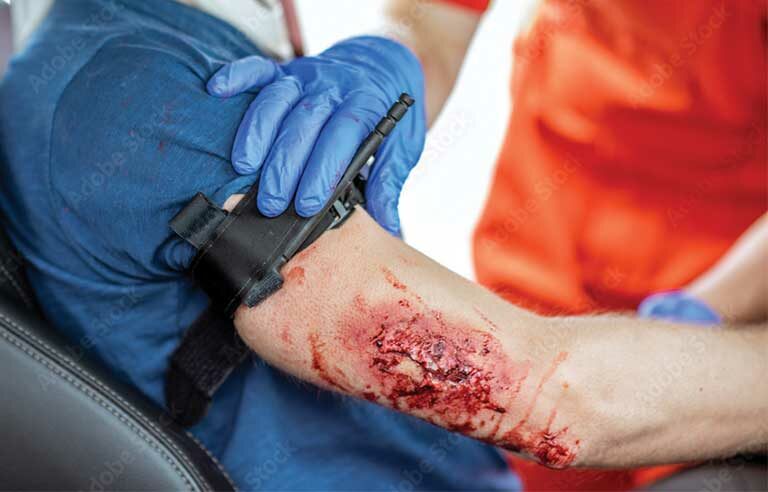Treating a bleeding injury
How do I know if a bleeding injury is serious?

Responding is Paul Slot, marketing manager, UniFirst First Aid + Safety, St. Louis.
Because serious bleeding injuries can be fatal, you must know the signs for which injuries are more serious and quickly take action. Traumatic injury is one of the leading causes of death for people 50 and younger in the United States. A large portion of those deaths involve severe bleeding. Yet, bleeding is the most treatable cause of death resulting from trauma.
Increasing educational efforts has helped prepare everyday people – and employees – to learn to be immediate responders and potentially save someone’s life in a bleeding emergency. In the most recent ANSI standard on workplace first aid (ISEA/ANSI Z308.1-2021 Appendix B.1), guidance was added to suggest that employers carefully consider providing uniquely packaged and designated bleed-control kits. It lists essential bleed-control items of these kits, including chest seals, compression bandages, hemostatic bandages, thermal blankets and tourniquets. The requirement for an arterial tourniquet for all Class B first aid kits was also added to the standard.
The most serious bleeding injuries are often caused by falls from a great height, significant blows to the body, motor vehicle crashes, slicing or stabbing from sharp objects, shootings, and explosions/shrapnel.
Bleeding injuries come in all shapes, sizes, depths and levels of risk. Like many potential incidents on the job, though, there is the temptation to think “it won’t happen to me – it won’t happen here.” Part of your safety training should include emergency preparedness and emergency response, which goes into action when a dangerous incident occurs. Bleeding injuries happen in an instant and can cause death within three to five minutes. They’re considered arterial, venous or capillary, as well as internal or external, and, in many circumstances, occur simultaneously.
Arterial bleeding is usually life-threatening if not addressed immediately. The arteries transport blood from the heart to the rest of the body at high pressure. Because of that high pressure, the blood tends to spurt or pulsate.
Venous bleeding stems from the veins that carry blood back to the heart. Those veins are under lower pressure so the blood flows more slowly and continuously. Venous bleeding also can be life-threatening if left untreated.
Capillary bleeding is much more common in the tiny blood vessels connecting the arteries to the veins. The bleeding is superficial and often easy to control. Capillary bleeding is rarely life-threatening, unless accompanied by arterial or venous bleeding.
Internal bleeding injuries are often not visible and not accompanied by external bleeding.
External bleeding injuries are very apparent. The highest risk are penetrating injuries to the chest, abdomen and groin; amputation; and laceration of arteries and veins in the side of the neck and throat, thigh, inner forearm, inner upper arm, and ankle. Deep laceration of arteries and veins can cause significant blood loss quickly.
With significant blood loss, knowing the signs of hypovolemic/hemorrhagic shock is vital. The first stage of hypovolemic shock occurs when an injured person loses around 15% of their body’s blood (750 milliliters, or about 25 ounces). As more blood is lost, symptoms get worse, according to the Cleveland Clinic.
Symptoms include:
- Breathing faster than normal
- Feeling confused or anxious
- Sweating a lot
- Passing out
- Having skin that feels cool
- Feeling weak
- Having a low temperature and low blood pressure
- Having a fast heart rate
Similar to the use of CPR and AEDs for sudden cardiac arrest, the treatment for bleeding is best when started immediately by the nearest person able to help. Although the treatment and management of serious bleeding injuries aren’t covered here, workplace safety training includes courses in first aid and advanced bleeding control, which provide instruction for scene safety; requesting emergency medical services/911; applying direct pressure; and using compression bandages, hemostatic dressings (which accelerate the clotting process) and arterial tourniquets.
As a co-worker, knowing the signs of a life-threatening bleeding emergency and the immediate steps for treatment can make a life-saving difference.
Editor's note: This article represents the independent views of the author and should not be considered a National Safety Council endorsement.
Post a comment to this article
Safety+Health welcomes comments that promote respectful dialogue. Please stay on topic. Comments that contain personal attacks, profanity or abusive language – or those aggressively promoting products or services – will be removed. We reserve the right to determine which comments violate our comment policy. (Anonymous comments are welcome; merely skip the “name” field in the comment box. An email address is required but will not be included with your comment.)

